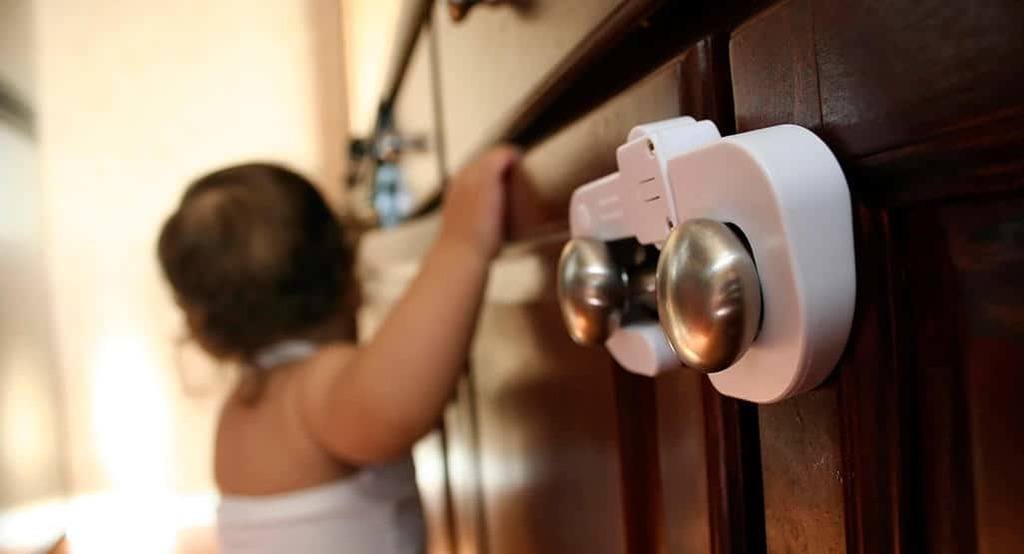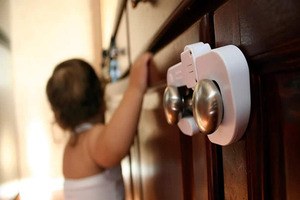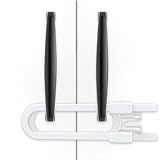- You are here:
- Home »
- Buying Guides »
- Best Child Proof Cabinet Locks
Best Child Proof Cabinet Locks


If toddlers have one special gift, it’s breaking all the house rules in the most cheerful and non-malicious way possible.
Part of this is down to their unique and broad sense of possession. You know the old saying: if it’s theirs, it’s theirs; if it’s yours, it’s theirs; if the dog’s having fun with it, it’s theirs…
If it’s behind a locked door, it stands some chance of staying out of their sticky, curious little hands.
This is just as well, since nearly a million babies and toddlers are admitted to the ER every year, having gotten access to a cupboard with medicines or cleaning fluids. That scenario is the stuff of nightmares.
If your baby is just about sitting up, then this is the time to start fitting those locks. It might seem early, but they will be crawling before you know it, and your lower drawers will become a forbidden toys playground.
There are a lot of baby-proofing cabinet options out there, so we’ve picked some of the best across a range of designs. You might want to double up as they serve very different purposes.
After showing you our five favorites, we’ve given you a little buyer’s guide to help you figure out which combinations best suit your home. Finally, we’ve answered a few frequently asked questions about making your home safer in general.
In a hurry? Here’s our top pick.
![]()
- 12 LOCKS and 2 KEYS:Vmaisi Baby Proofing Adhesive Magnetic Cabinet Locks, Child Safety for Drawers and Cabinets
- WORKS FOR MOST CABINETS AND DRAWERS: Baby proofing magnetic cabinet locks work on cabinets and drawers door for childproof. Use them in the kitchen, bathroom, pantry room, storage area, and bedroom. Magnetic Cabinet Locks do not work with any metals.
- INVISIBLE FROM OUTSIDE: Cabinet Locks install inside cabinets or drawers, concealed from children and guests, making your home more appealing, while cabinet locks child safety also providing ideal child protection
- KEEP YOUR BABY SAFE: The magnetic baby safety lock is to keep your curious little kids away from drawers and cupboards filled with dangerous tools with simple, Baby safety cabinet locks allowing you to have peace of mind while your children explore your home
- MAGNETIC LOCKING SYSTEM: Baby Safety Magnetic cabinet locks install on the inside of your cabinet or drawer. The fixings are secured with tape to keep your locks in place. Magnetic keys are provided to disengage the locks. Should you misplace the keys, any strong magnet can be used to disengage the lock
Best Child Proof Cabinet Locks – Comparison Table
Best Child Proof Cabinet Locks – Reviews
This first product is great for those of you who hate groveling around in confined spaces.
Trying to mark where on the inside roof you need to put the lock, then place it, then screw the body of the lock into place is not great on your back—or your wrists, if you have arthritis.
VMAISI locks have a simple four-step process which helps you to line up both the latch which goes on the back of the door and the catch which sits on the underside of the cabinet, acting as the lock. The lock is invisible from outside of the cabinet.
To open it, you press the key against the magnetic lock from the outer door and the magnetism will pull the latch’s lever out of the door catch. (Say that ten times fast!)
They provide screws, if you want to reinforce the lock against a strong, curious dog of 30lb or over, but the adhesive is extremely strong.
And because the lock will keep the doors fully closed, there is no danger of your little one managing to open it part way before they get their fingers caught.
You get 2 keys with your 12 locks. Your next trick is to find somewhere safe to keep those keys.
- It comes with an alignment tool to make it easier to install evenly.
- Good value for money.
- An elegant, “invisible” solution.
- No screws required (unless you want to reinforce the lock).
- If you can’t find the keys, then you can use a strong magnet to open the doors.
- They will only work on wood or other non-metal cabinets.
- They’re difficult to install in drawers which are narrow or shallow.
You know those D-locks you can get for your bike? These work in a similar way, used to join door knobs or vertical handles within 4.5” of one another.
The locks come in two parts: a narrow U-shaped holder, and the latch base. Slide the back part of the U inside the handles and click on the base. That’s it—job done. To remove the lock, pull together the two small plastic tabs at the base of the latch.
It’s easy for you, but not obvious to a baby or toddler as a solution for opening this lock.
No screws, no installation time, and no damage to your furniture takes place whatsoever. These are ideal if you’re having guests with children coming to stay, or if you’re taking your family to a self-catering place on vacation.
The standard pack comes with four white locks, but you can order packs of 8 and 12, and still spend under $20.
- Inexpensive.
- Effective and easy to use.
- Portable.
- You can tighten the lock so that your toddler can’t even open the doors a quarter inch.
- They’re great for protecting side-by-side or French-door refrigerators from large dogs.
- Only works for proximal handles.
- They’re not a very elegant solution.
With your basic spring lock, you attach the body of the lock to the back of the door (or near-inside of the drawer), fix the catch on the upper side of the cabinet interior, and the hook on the catch will press up into place when you shut the door.
All you need to do to open the door is ease it open an inch and press down on the latch. This is easy for you, but difficult for your toddler. If your cabinet has a lip, you don’t need to install the catch at all.
Both the body of the latch and the smaller stationary catch are 1.5” wide, and the hook about 3/16” across. This makes it very easy to eyeball the relative positions while you’re installing them. The process doesn’t require finesse or the use of a ruler.
As with the VMAISI locks, they come with strong adhesive strips with screws for back-up. They’re versatile and inexpensive, and can work on the side, bottom or top of any hinged door. They’re also good for large cutlery drawers.
These locks do take a little force to remove and will keep very little children and high-energy pets out of those forbidden places.
- Inexpensive.
- Good value for money.
- Easy to operate—no keys to lose.
- Reasonably versatile.
- Invisible appearance.
- Little fingers can get bruised trying to get the door open.
- Some have found these a little tricky to install.
These adhesive-backed straps are the most versatile of this collection. You can seal any cupboard, drawer, or closet, regardless of handle design, or how close they are together.
Most importantly, you can apply this strap around corners because they’re not just flexible—they will adhere to any material. Stainless steel, porcelain, wood, laminate countertops… you name them.
This means you can also secure the freezer and fridge. You can bend the strap around the edge of a toilet seat. If absolutely necessary, you can add an extra layer of security to your baby gate to keep your teeny Houdini in their room when they’re supposed to be napping, not “investigating stuffs,” as toddlers call their trail of destruction.
You can keep your little one safe from the steam that blasts from a dishwasher when the cycle has been interrupted at the hottest point.
All you need to do is fix one end in place, figure out how long you need the strap for total security, make your adjustment, and then fix the catch end of the strap in place.
When you need to open a door, then simply apply a press-and-pull action to the catch and the strap will fall away.
- The most versatile locks.
- Very strong adhesive and strap.
- Portable.
- Inexpensive.
- Great peace of mind.
- Not the most elegant solution.
- Some have found the straps difficult to remove when they’re no longer needed.
These basically look like cowboy ties attached to side-by-side knobs or vertical door handles.
They work much in the same way as the Adoric U-locks, except that they’re more flexible and can securely fasten handles up to 6.5” apart. You can get these in black or white.
They’re light. They’re easy to apply and then remove one-handed, which is convenient when you’re holding baby on one forearm while finally retrieving their rusks from the cupboard with the other.
You can take them on vacation with you, or just to a friend’s house if you’re staying a few nights. Like the U-lock, they don’t mark or change furniture in any way and they’re totally portable.
Kiscords have provided some very clear instructions on how to ensure that the doors will not open so much as a quarter inch when the ties are fixed correctly. They’ve even provided a YouTube video to remove the possibility of miniature, bruised fingertips.
It’s good to see that they have the smaller dangers in mind as well as the larger risks of little ones getting at substances that they need to be kept safe from.
- Easy to apply.
- Easy to remove one-handed.
- Do not affect, mark or change the furniture in any way.
- A low-key appearance.
- They keep the doors fully shut when applied properly.
- It would be nice to have a choice of black and white ties in one pack.
- Only works for doors with side-by-side handles.
Best Child Proof Cabinet Locks – Buyers Guide
Now that you’ve seen what’s on offer out there, you might already have a good idea of which child/baby-proofing solutions suit you best.
To help you decide which combination or set of locks is best for you, we’ve pulled together a list of things to take into account before you hit the ‘buy’ button.
Versatility and Budget
If you’ve already spent your worldly cash on baby buggies or prams, then you’ll want something plentiful, inexpensive, and which can be fitted anywhere. In which case, the adhesive straps might be your best bet.
They’re the only locks which can be applied around corners, and they’re robust enough to protect your toddler as well as your crawling-alarmingly-fast baby.
How well you know your own child
Kids are getting taller these days. This generation of babies will most likely be five feet tall by the time they’re 10. That’s a little scary, isn’t it? If you’re not the tallest of moms, then you’ll have to stand on the naughty step to make eye contact with them by the time they’re 12.
And although they remain cute for a long time, they do not remain tiny.
They’re also sometimes smarter than we give them credit for
So, if you have a tall baby, or one who is spookily good at learning from watching, then the spring-based locks may only work until they’re about 18 months old. And then you’ll have to opt for something more complex.
However, if you have a shorter or more chilled baby who isn’t inclined to open a door just because it’s shut, then this kind of lock has a longer operational life. The Adoric U-lock, likewise, is complicated only if you don’t know how to work it.
The design is intended to be difficult for little fingers, but a smart older toddler, with hands strengthened from shaking baby gate bars, could get to grips with how these work before their fourth birthday.
Just have a think about how fast your baby is likely to evolve into a proficient escape artist, and plan ahead if you think those days are coming within the next year.
You can always double up on magnetic locks and exterior straps if need be.
Strength & Permanence
Sometimes it’s not just the babies and toddlers you need to protect.
Children with special needs between 3-7 years old can be as strong as they are inquisitive, and they’re not easy to coax out of investigating a closed-off space if they’re worried that they’ve lost something that’s been tidied away.
In which case, you’ll want an ‘invisible’ solution which doesn’t draw attention to itself, and something which is going to stay put, even when significant pressure is applied. If you’re not planning to move home any time soon, then your solution may be to use the magnetic locks but reinforce the strong adhesive with screws.
After all, what’s a few screw holes in a kitchen if you’re not trying to sell the place on? At least they’re still discreet.
If you have an upscale home with expensive or antique furniture, then you’ll most likely want to stick with the locks which do not include any kind of fixings or adhesives (the tie-cords or U-tube solutions). These are also the most portable form of child-proofing, and they’re great for grandparents whose kids and grandkids visit often.
As someone who wants their home child-proofed part time only, you won’t want to battle with spring or magnetic locks until they’re necessary to use.
Your own convenience
The magnetic locks included in our choice are designed to stick into place with just a minute’s positioning prep for each one.
If the cabinet space is awkward for seeing what you’re doing while applying tiny screws, then you might want to double up: use two keys at top and bottom of the cupboard instead of trying to find a cordless driver with a magnetic tip and LED light so you can see what the heck you’re doing.
Or perhaps there are only a couple of cupboards in the whole place that you want to protect now, and the others are best placed on kitchen white goods to protect your child from immediate and serious danger. In which case, the semi-permanent straps will come to your rescue.
Overall, just weigh up the likelihood of the special cupboard or drawer being breached against the longevity of that solution. Where possible, keep your back to your child when you’re opening the lock to defer the day when they figure out how to do this themselves.
And as soon as you suspect that they’re close to cracking the code of getting that door open, then change the locks. Don’t leave anything to chance.
Frequently Asked Questions
How do I stop my toddler from locking the door?
Getting locked out when you’ve literally taken two steps to grab the paper can make for the beginning of a totally awful day. There are two solutions to this; firstly, make sure you never move two feet without keys.
This is easier said than done—grabbing your keys is not automatic before seven in the morning. Secondly, make sure that your door has a latch. If it has a fixable latch, then you will have to train yourself to click the safety into place before stepping outside. Ever.
However, if it’s a simple press-down door handle, then get a thick rubber band (or stretchy hairband) and form an X across the latch, securing it into place using the handles on either side of the door for tension. It’s temporary and not ideal, but it may stop you being stranded on the doorstep.
Some moms make a mold of the latch gap in the door casing and then shove a rubber bung into that hole if they’re just stepping outside for a few seconds at a time.
How do I child-proof my living room?
Okay, now that you’ve secured your DVD cabinet, locked the X-box and controllers away, and you’ve got any alcohol magnetically secured, there are other things you can do to keep baby from harm. The trick is to get down low and see things from your baby’s point of view.
Where are the sharp corners? Are there any edges they could graze themselves on? Straighten out rugs. Make sure that the cabling for your TV or media center is bound tidily, and, if possible, out of sight. Gently rock furniture; does it stay put?
Adjust, fix or ditch unstable bookcases which will rebound off the wall and into your child if they toddle into them at speed.
How do I get rid of left-over glue from strong adhesive pads?
You can use an old credit card to scrape off the immediate residue, and then gently dab the area with nail polish remover/acetone/rubbing alcohol, which releases the adhesive bonds.
If you’ve attached an adhesive strap to wood, then it’s safest to use a commercial cleaner that’s made specifically for the purpose.






